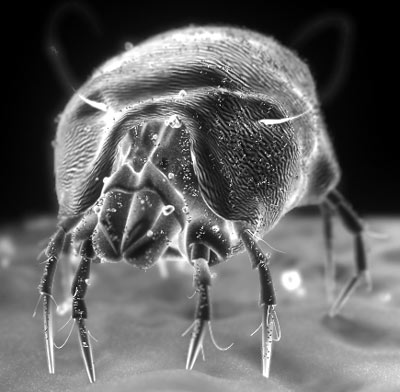Common Allergens
Common indoor allergens includes
- Dust Mite Allergen
- Animal Dander
- Mould Allergen
- VOC (Volatile Organic Compound)
- Cockroach Allergen
Dust Mite Allergen
 Over 90% of allergic individuals are allergic to dust mite allergens.
Over 90% of allergic individuals are allergic to dust mite allergens.
House dust is a mixture of various waste material like dead human skin cells, animal dander, fabric fibres, dust mites, bacteria, cockroach parts, mould spores, food particles and other debris. Of these, dead skin cells account for up to 80% of house dust. However, it is the house dust mite allergen that is the most common contributor to allergic asthma, allergic rhinitis and atopic eczema.
Generally, if doctors say that patients are allergic to house dust, they usually refer to the house dust mite. Of course, patients could also be allergic to other elements of house dust, such as cockroach parts, animal dander, mould and so on.
What are house dust mites?
Dust mite are eight-legged little creatures that belongs to Arachnid family (spider and tick family). They are usually invisible without a microscope and feed on animal materials with high potein content, especially dead human skin cells.
The female dust mite lay up to 50 eggs within 3 weeks. The average lifespan of dust mites is about 10 weeks, each female dust mite would have laid between 40 to 80 eggs. It is easily seen that they multiply at a very fast rate, especially at right conditions - which is warm, humid and with plenty of food.
What is dust mite allergen?
The common misconception is that the dust mite itself causing the allergic reaction. Actually, it is the faecal dropping of the dust mites, as well as their decaying body parts, which contain the offending allergen - an enzyme present in their digestive system.
A dust mite can produce 20 droppings per day. Some estimate 10% of a two-year-old pillow's weight can be made up of dust mites and their droppings.
Where do dust mites live?
Dust mites thrive best where the relative humidity is about 70% and temperature above 24 degrees Celsius. As such, sub-tropical climates like Hong Kong would have a high dust mite population than temperate climates like Europe or North America.
Within the home, most of the dust mite colonies can be found in bed mattress, pillows and duvets. This is because these areas have high concentration of:
- food - we shed a lot of skin cells throughout the day,
- humidity - we perspire when we sleep, and there is vapour in our breath,
- warmth - our body heat.
Other area which are particularly susceptible to dust mites are the carpet or rug, soft toys, upholstery and anything else that can trap dust - e.g. curtains and cloths.
Animal Dander
 In US, the American Academy of Asthma, Allergy and Immunology (AAAAI) estimates that 10% of the population are allergic to animals, and 20% to 30% of individuals with asthma have animal allergies.
In US, the American Academy of Asthma, Allergy and Immunology (AAAAI) estimates that 10% of the population are allergic to animals, and 20% to 30% of individuals with asthma have animal allergies.
For those who are allergic to existing pets, the most effective approach is to give the pet away. However, allergen has been known to remain in the house long after the pet is gone.
What cause pet allergies?
Fur or feathers do not cause the reaction! Rather, it is the protein found in the saliva, dander (dead skin flakes) or urine of an animal. These tiny proteins can easily being stirred up and remain airborne for hours. Some people react within minutes of exposure, while others might take 8 to 12 hours to develop symptoms.
Cat allergy usually refers to dried saliva on their fur (cats lick themselves). Dog allergy is mainly caused by their dander which is constantly being shed into the environment. Birds usually shed dander in the form of feather dust, and they become airborne with the birds flutter about. Allergies to small furry pets like hamsters, guinea pigs, mice and rabbit are caused by their urine.
A highly sensitive individual can consider keeping fish, turtles, frogs or tortoises as pets. These pets do not shed dander or have hair or fur, and their droppings do not create allergic problems.
Mould Allergy
What is mould ?
 Moulds are microscopic fungi. They grow in clusters of filaments. Unlike plants, moulds cannot produce their own food from sunlight. They survive by decomposing other organic matters.
Moulds are microscopic fungi. They grow in clusters of filaments. Unlike plants, moulds cannot produce their own food from sunlight. They survive by decomposing other organic matters.
Moulds breed by releasing spores in the air, which then settle on organic matter and then grow into new mould clusters. There are far more numerous airborne mould spore then pollen grains. These spore are the substance that cause mold allergies.
Where are moulds found?
Moulds are found almost everywhere - both indoors and outdoors. Warm and humid condition will encourage mould growth. Thus hot and humid tropical environment like Hong Kong are perfect for mould to growth. For outdoor environments, they grow best in shady and damp areas. Moulds spore produced outdoors can be widely spread and then enter homes along with air flows.
Moulds can also growth within air conditioning systems. This could be a source of sick building syndrome or building related illness, including allergic reactions.
